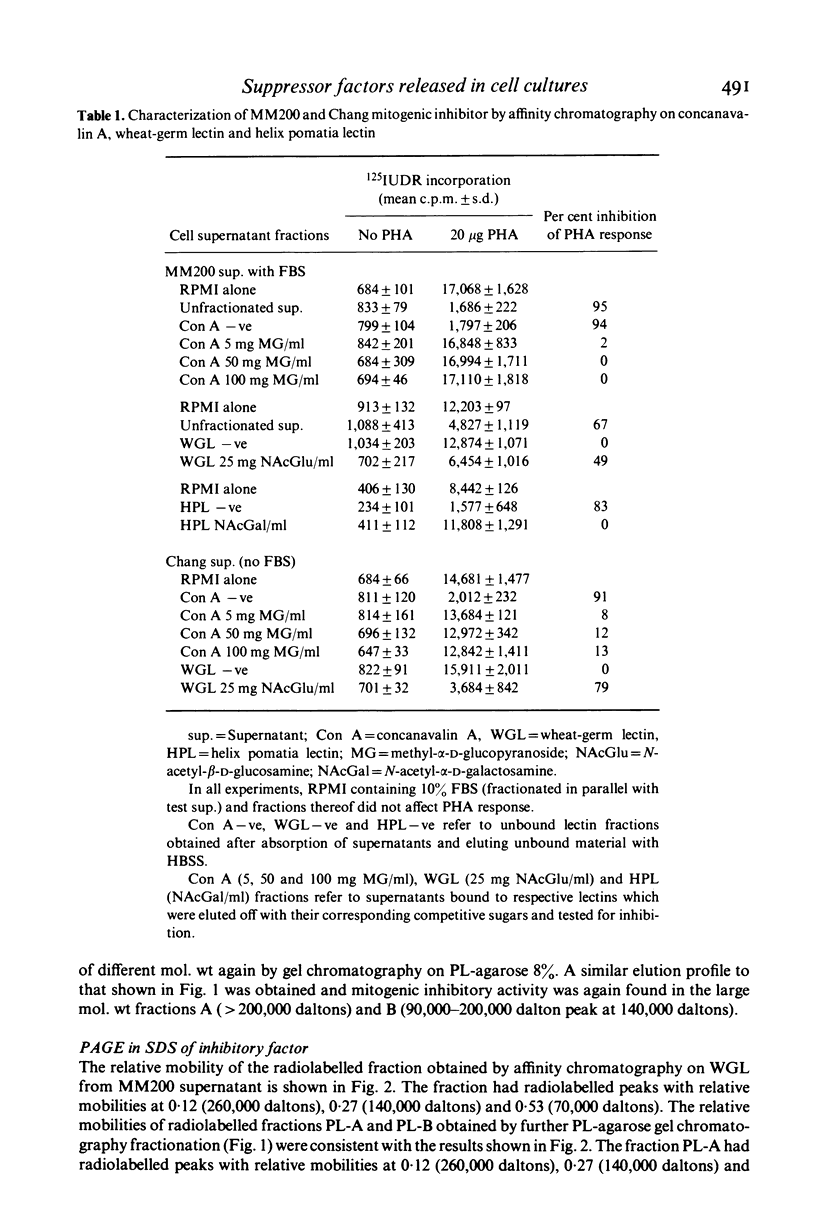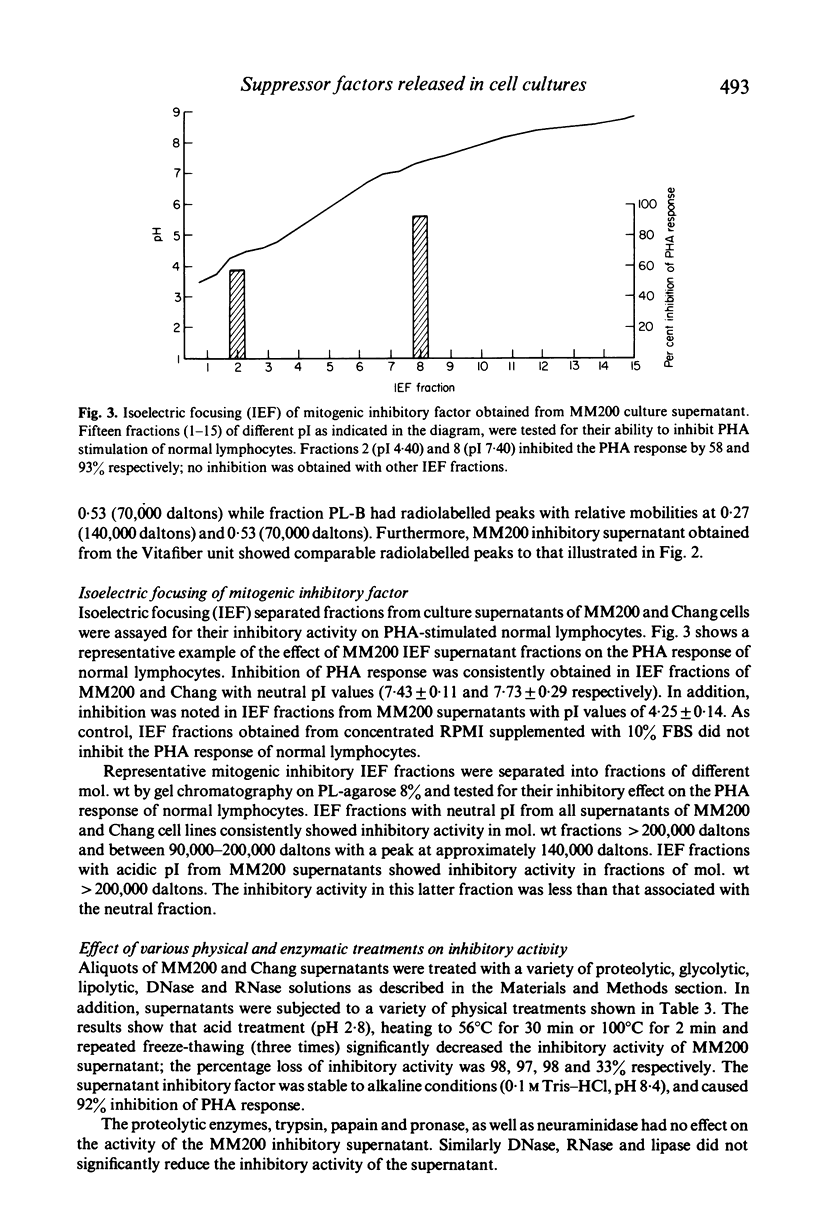Abstract
We have previously shown that tumour cells may release soluble factors which inhibit the division of a variety of cells. These factors had marked immunosuppressive activity in vitro as shown by their ability to inhibit lymphocyte mitogenic responses to lectins, allogeneic lymphocytes and pokeweed mitogen-induced immunoglobulin production. It was postulated that these factors may play an important role in determining the outcome of tumour–host interactions in humans and be the source of immunosuppressive factors in the circulation of patients with cancer. In the present study, characterization of these mitogenic inhibitory factors released into the supernatants of cultured tumour cells was carried out by a number of sequential separation procedures involving affinity chromatography on wheat-germ lectin (WGL), gel filtration on PL-agarose and electrophoresis in polyacrylamide gels in the presence of sodium dodecyl sulphate (PAGE–SDS). The factors were identified throughout the separation procedure using inhibition of phytohaemagglutinin (PHA) stimulation of normal lymphocytes as an index of inhibitory function. By these techniques the inhibitory activity was shown to be associated with glycoproteins containing N-acetyl-β-D-glucosamine (NAcGlu) and having molecular weights (mol. wt) of approximately 140,000 and over 200,000 daltons. A further small mol. wt peak of 70,000 daltons was observed on PAGE–SDS. pI values of the fractions were 7·4 and 4·2. The activity was destroyed by heating, low pH and repeated freeze-thawing but was resistant to proteolytic enzymes, deoxyribonuclease, ribonuclease and neuraminidase. The active fractions were not associated with proteolytic activity and the inhibition of mitogenic responses was irreversible in nature. These results form the basis of studies to detect this factor in biological fluids and further evaluate its role in the tumour–host relationship.
Full text
PDF









Selected References
These references are in PubMed. This may not be the complete list of references from this article.
- Böyum A. Isolation of mononuclear cells and granulocytes from human blood. Isolation of monuclear cells by one centrifugation, and of granulocytes by combining centrifugation and sedimentation at 1 g. Scand J Clin Lab Invest Suppl. 1968;97:77–89. [PubMed] [Google Scholar]
- Fairbanks G., Steck T. L., Wallach D. F. Electrophoretic analysis of the major polypeptides of the human erythrocyte membrane. Biochemistry. 1971 Jun 22;10(13):2606–2617. doi: 10.1021/bi00789a030. [DOI] [PubMed] [Google Scholar]
- Fauve R. M., Hevin B., Jacob H., Gaillard J. A., Jacob F. Antiinflammatory effects of murine malignant cells. Proc Natl Acad Sci U S A. 1974 Oct;71(10):4052–4056. doi: 10.1073/pnas.71.10.4052. [DOI] [PMC free article] [PubMed] [Google Scholar]
- Graham R., Graham J. Cancer camouflage. Surg Gynecol Obstet. 1969 Apr;128(4):735–744. [PubMed] [Google Scholar]
- Hersey P., Honeyman M., Edwards A., Adams E., McCarthy W. H. Antigens on melanoma cells detected by leukocyte dependent antibody assays of human melanoma antisera. Int J Cancer. 1976 Nov 15;18(5):564–573. doi: 10.1002/ijc.2910180504. [DOI] [PubMed] [Google Scholar]
- Lipkin G., Knecht M. E., Rosenberg M. Restoration of in vitro growth control to malignant cells. Cancer. 1977 Nov;40(5 Suppl):2699–2705. doi: 10.1002/1097-0142(197711)40:5+<2699::aid-cncr2820400943>3.0.co;2-k. [DOI] [PubMed] [Google Scholar]
- Murray E., Ruygrok S., Milton G. W., Hersey P. Analysis of serum blocking factors against leukocyte dependent antibody in melanoma patients. Int J Cancer. 1978 May 15;21(5):578–587. doi: 10.1002/ijc.2910210507. [DOI] [PubMed] [Google Scholar]
- Nelson M., Nelson D. S. Macrophages and resistance to tumours. I. Inhibition of delayed-type hypersensitivity reactions by tumour cells and by soluble prducts affecting macrophages. Immunology. 1978 Feb;34(2):277–290. [PMC free article] [PubMed] [Google Scholar]
- Pike M. C., Snyderman R. Depression of macrophage function by a factor produced by neoplasms: a merchanism for abrogation of immune surveillance. J Immunol. 1976 Oct;117(4):1243–1249. [PubMed] [Google Scholar]
- Reisfeld R. A., David G. S., Ferrone S., Pellegrino M. A., Holmes E. C. Approaches for the isolation of biologically functional tumor-associated antigens. Cancer Res. 1977 Aug;37(8 Pt 2):2860–2865. [PubMed] [Google Scholar]
- Werkmeister J., Zbroja R., McCarthy W., Hersey P. Detection of an inhibitor of cell division in cultures of tumour cells with immunosuppressive activity in vitro. Clin Exp Immunol. 1980 Apr;40(1):168–177. [PMC free article] [PubMed] [Google Scholar]
- Wilson E. L., Dowdle E. Secretion of plasminogen activator by normal, reactive and neoplastic human tissues cultured in vitro. Int J Cancer. 1978 Oct 15;22(4):390–399. doi: 10.1002/ijc.2910220405. [DOI] [PubMed] [Google Scholar]


